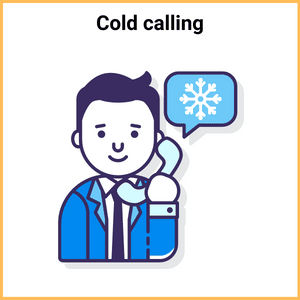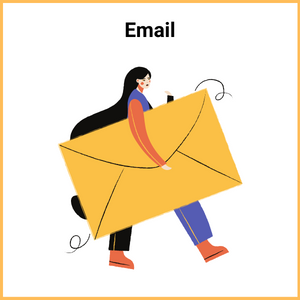Prospecting is a crucial part of the sales process. It’s also a lot of time and effort. So much so, in fact, that it’s the part of sales that most salespeople struggle with the most. That’s why you could use a hand.
This rundown of the 5 best B2B prospecting methods is designed to help you do just that. It will also offer some tips on how to make the most of more traditional options.
Cold Calling
There’s a common misconception that cold calling doesn’t work. But it’s still a very effective method for B2B prospecting.
Cold calling is a technique in which a salesperson contacts people who have not yet expressed an interest in the products or services on offer. Cold calling generally refers to solicitation by telephone or telemarketing, but can also involve face-to-face visits, for example with door-to-door salespeople.

Today, cold calling can be both fast and cost-effective. Modern VoIP phone systems enable a company’s sales staff to make a high volume of calls in a short space of time. And you can do it at a fraction of the cost of traditional telephony.
You need to get organized beforehand to identify the people you’re going to call. Look at your current customers, look at the industries they work in, look at the positions they hold and the concerns they have. Once you’ve identified this, you can buy company files from chambers of commerce. The more accurate the files you create, the more likely you are to find prospects who really need your products and solutions.
Social networking
The Internet and social networks have profoundly altered consumer behavior, turning traditional sales prospecting methods upside down as consumers consider them too intrusive.
Not every social network is right for every business.

First, you need to identify the right social network for your business, based on the age of your current customers and their use of social networks.
In B2B, for example, it will be advisable to use Linkedin or Facebook, as this is where the decision-makers are.
On Linkedin and Twitter, it’s going to be relevant to get in direct contact with users similar to your current customers. Describe why you’re contacting them and what’s in it for them. You can also offer them relevant content to help them.
On Instagram, Tiktok and Snapchat, you’re going to want to create content that will appeal to your prospects, so that they come to you rather than the other way around. That’s inbound marketing.
On Facebook, you can use groups. People with the same interests come together in groups, and it’s the perfect way to find out who to approach.
Customer network
You’ve worked hard to turn prospects into leads and ultimately into customers. At the end of the sales process, you don’t have to write these customers off and never contact them again. Contacting them and asking for references is an intelligent form of prospecting.
Your customers will know many other people in niches and jobs similar to their own. Chances are, many of them also belong to your target audience. If a customer is willing to refer you to their contacts, it can make a huge difference to your overall sales.

Timing is everything when it comes to customer referrals. They will continue to familiarize themselves with your product or service. Sometimes they’ll even recommend you on their own, but be as proactive as possible in this process, offering them benefits and rewards.
Email campaigns are the easiest way to find new customers. Many sales companies rely heavily on e-mail prospecting. An email is quick to write, easy to send and costs nothing.
The more personalized your emails are, the better they’ll work. Again, base your emails on your existing customers and find similar databases to which you can send emails.

In the email :
- Describe why you’re sending this email (the prospect’s interest)
- Who you are
- Add relevant content that can help
- Give them a clear and simple action to take (Visit our site, call me…)
Finally, send out follow-up emails in case your prospects don’t respond to the first one. They might respond to the second or tenth, who knows.
Create content
Content marketing is the art of communicating with your customers and prospects without selling. Instead of presenting your products or services, you provide information that brings value to your buyer. By providing valuable, educational information to your customers, you create a level of trust.
People who interact with your company’s content (blog posts, videos, case studies) are often potential prospects. So the more useful content you create, the more qualified leads you’ll attract.
The article you are reading is an example of content marketing. We’re trying to provide relevant content for visitors to our site to try out our application for sales people.
